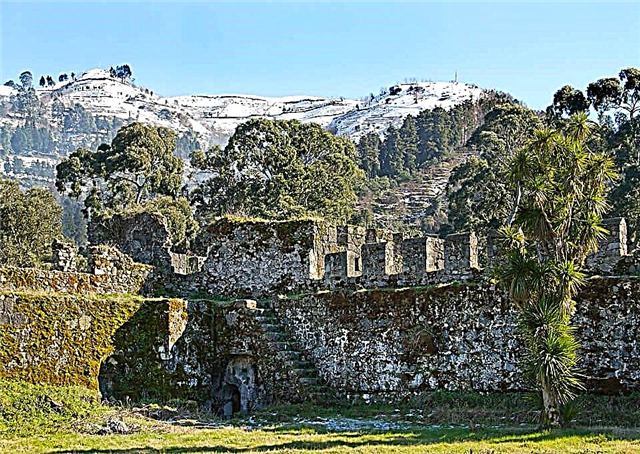Address: Moscow
First mention: 1669 year
Disassembled: 1929 year
Start of construction: 1994 year
Completion of construction: 1995 year
Architect: Matvey Fedorovich Kazakov
Shrine: List of the miraculous icon of the Iberian Mother of God
Coordinates: 55 ° 45'20.5 "N 37 ° 37'04.6" E
Content:
In the very center of the capital, in the pedestrian zone near Red Square, there is a small elegant chapel, and believers come there at any time of the year. The history of the revered Orthodox church begins at the end of the 17th century. It contains a copy of the famous icon, the original of which has been kept in a monastery on the Greek peninsula of Athos since the 11th century.

Iverskaya chapel against the background of the Resurrection Gate
History of the icon
Art critics and historians do not have a common opinion about the age of the icon of the Iberian Mother of God. The University of Athens believes that this image was painted in the first half of the 11th century, and the staff of the Leopold and Franz University, located in the Austrian city of Innsbruck, claim that it was created later, in the 12th century.
The appearance of the miraculous icon is recorded in the Christian Legends. The Slavs first wrote about the amazing icon in the 15th century, and the Greeks in the 16th century. There are completely different versions of its origin in the annals. According to one of the surviving legends during the time of iconoclasm, under the Byzantine emperor Theophilus, a woman lived not far from the Greek city of Nicea. Realizing that the icon could be taken away and destroyed, she decided to save the face of the Mother of God from her pursuers and lowered the icon into the sea.
Two centuries later, the image ended up in the hands of the monks and was placed in the Iberian monastery, which was founded at the end of the 10th century by immigrants from Georgia, descended from the royal family of Bagratids. It was from the monastery that the icon got its name "Iverskaya".
At first, she was kept in an icon case, placed above the entrance to the cathedral church, and was called the "Goalkeeper". The Saracens once attacked the peninsula. One of the barbarians drove up to the monastery and hit the icon with a spear. According to legend, at the same instant, blood spurted out of it. Seeing this, the robber repented and took monastic vows.
Then a small separate church was erected for the icon. In the 16th century, Georgian chasers made a silver setting for the image, in which only the faces of the infant Christ and the Mother of God remained open. The icon is kept in the ancient Iversky monastery to this day.

General view of the chapel
How the first chapel was built
Lists or copies of the famous Athos icon began to be made a very long time ago. Believers believed that they, like the original, have miraculous properties and help in solving life's problems and healing from ailments. In 1648, the abbot of the Novospassk monastery, Archimandrite Nikon, asked the inhabitants of the Athonite monastery to bring the original icon to the Russian capital. The monks did not want to part with the shrine, and then the iconographer Iamblikh Romanov created an exact copy of it. A skilled craftsman drew the list on a cypress board using paints mixed with holy water.
The abbot of the Iberian monastery, Archimandrite Pakhomiy, himself brought the icon to the royal court. At first, the image was placed in the Nikolsky monastery, and then transported to the Valdai Iberian monastery. According to the chronicles, in 1651, thanks to the new icon, the tsar's daughter managed to recover. Delighted, the Russian sovereign Alexei Mikhailovich generously thanked the Iversky Monastery and presented him with the monastery of St. Nicholas, located in the Moscow Kremlin.
After 8 years, special for Moscow, the Athos iconographers created another copy of the icon and brought it to the capital. In 1669, a small canopy was built near the Neglimen Gate, so that the new icon would have reliable protection in rain and snow. The place for the miraculous icon near the twin gates of Kitai-Gorod was not chosen by chance. Through them the Russian sovereigns solemnly entered Red Square.
In 1680, the canopy was replaced with a wooden temple. It is noteworthy that in 1722, according to the Synodal Decree, almost all Moscow chapels were destroyed, however, they did not dare to touch the Iverskaya chapel.

Construction of a stone temple
The wooden church stood until the end of the 18th century and was badly dilapidated, so it was decided to replace it with a stone one. The project of the new chapel was carried out by the talented Russian architect Matvey Kazakov, and the Italian master Pietro Gonzago was entrusted to decorate it. According to his sketches, the chapel was covered with tin and decorated with gilded stars and copper pilasters. A graceful gilded angel holding a cross appeared at the top of the temple.
The small church was consecrated in 1791, and Muscovites immediately liked it. Although no more than 50 believers could get into the chapel, people came here to pray from different parts of the city. Not only Orthodox Christians went to the miraculous icon. She was also revered by Catholics who came to Russia on government or commercial matters. Merchants always went to the chapel before important transactions, and high school students and students asked the Mother of God for good marks in exams.
From time to time, the famous icon left the chapel. By order of the residents of the city, the image was taken to their homes to heal the sick and help women in labor. So that the Iberian chapel did not remain empty, a copy was made of the image and hung in the vacant space.
For several centuries in Moscow there was a tradition according to which the emperor arriving in the city first of all went to venerate the Iberian icon. This rule was broken only once. In 1699, the young Peter I returned to Russia from his first trip to Europe. Instead of the Iberian Icon, he hurried to his friends in Lefortovo, and this act caused a sharp condemnation of the townspeople. After that, Peter I and other Russian sovereigns, arriving in Moscow from St. Petersburg and returning to the northern capital, always prayed in the Iberian chapel.

Before the invasion of French troops in early autumn 1812, the famous icon was taken out of Moscow. So that the enemies could not outrage the Orthodox shrine, they hid it in one of the Vladimir monasteries. However, two months later, after the French left the city, the icon was returned to the Moscow chapel. Then the temple was restored, and the city began to hold an annual procession in honor of the liberation of the country from Napoleon. During it, crowds of believers with a miraculous icon in their hands walked around the walls of the ancient Kremlin.
Destruction and revival of the chapel
The fate of the small church changed dramatically with the advent of Soviet power. In the spring of 1918, a red star and a large anti-religious poster were hung on the Duma building next to the chapel. Then the temple was robbed. Moscow police opened a criminal case for theft, but the thieves were never found.
In 1922, a campaign was carried out in the country, during which valuables were forcibly confiscated from their temples and monasteries. People came to the chapel and took from it the miraculous icon and all the liturgical utensils. So Muscovites lost one of their main shrines. In 1923, on Christmas Eve before Christmas, the Komsomol members lit a huge bonfire in front of the church and defiantly burned religious objects in it.
In 1928, the city prepared a decision on the demolition of religious buildings and the subsequent reconstruction of the main square of Moscow. In the summer of 1929, the temple was closed to believers and within 24 hours was dismantled to the very foundation. The Resurrection Gate was demolished a little later - in 1931. The passage leading to Red Square was cleared and columns of demonstrators and equipment for parades began to flow through it.
The Moscow shrine was revived in the mid-1990s under the direction of the architect O. I. Zhurin. In the fall of 1995, the newly rebuilt chapel was consecrated and a new copy of the famous icon created by the Athonite masters was placed in it.

Angel on the dome of the chapel
What the chapel looks like today
The passage near a small church and the Resurrection Gate has long become a popular promenade where residents of the city and guests of the Russian capital like to walk. The restored chapel occupies a place between two arches of the historic gates. Its only entrance faces north - towards Manezhnaya Square.
The elegant one-storey building is painted green, white and gold. The dark blue dome is decorated with golden stars, and, like several centuries ago, it is crowned with the figure of an angel with a cross. The chapel is a functioning Orthodox church, and services are held here every day from 8.00 to 20.00.
How to get there
The chapel is easily accessible on foot from the Teatralnaya, Ploschad Revolyutsii and Okhotny Ryad metro stations.











